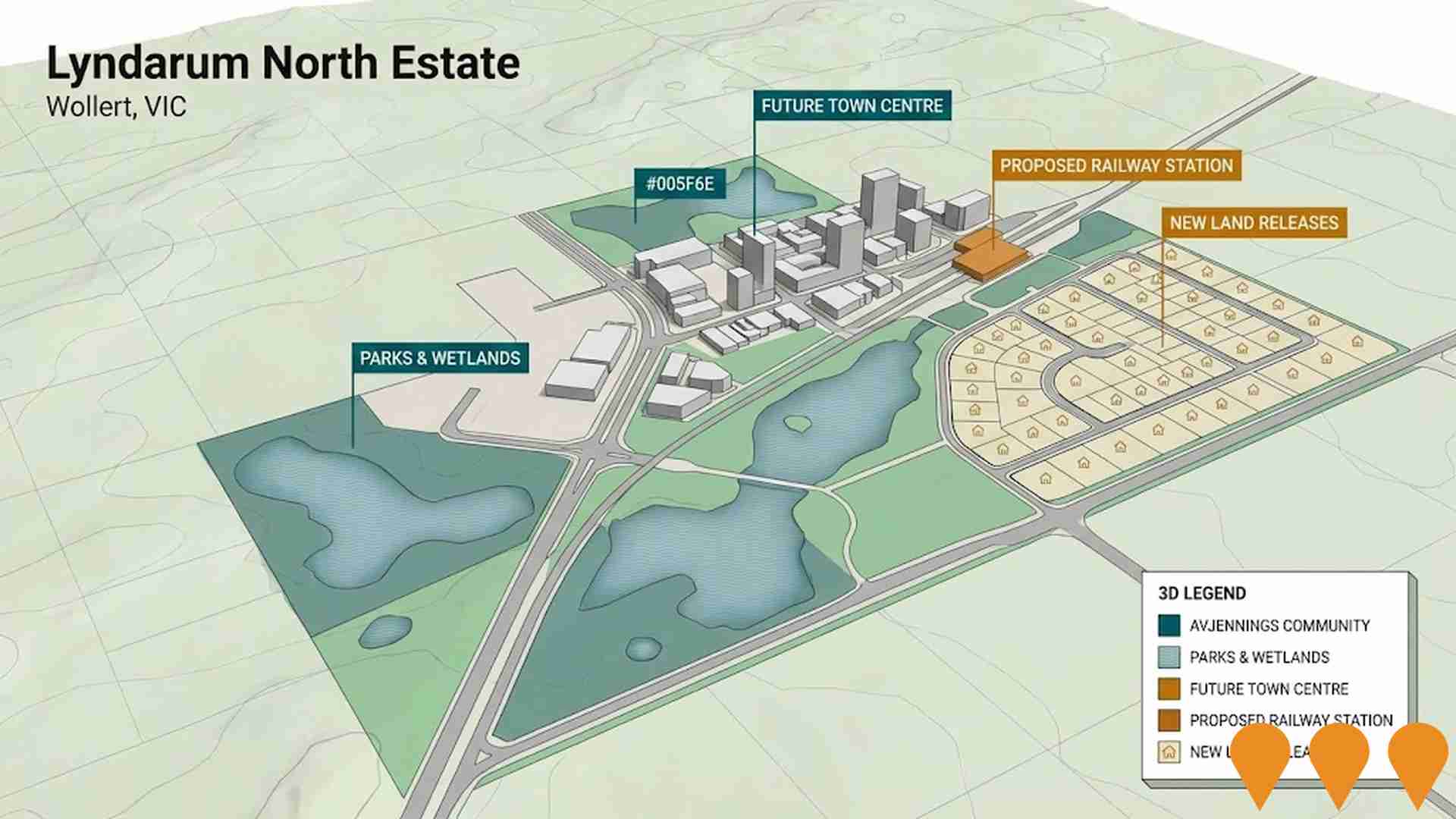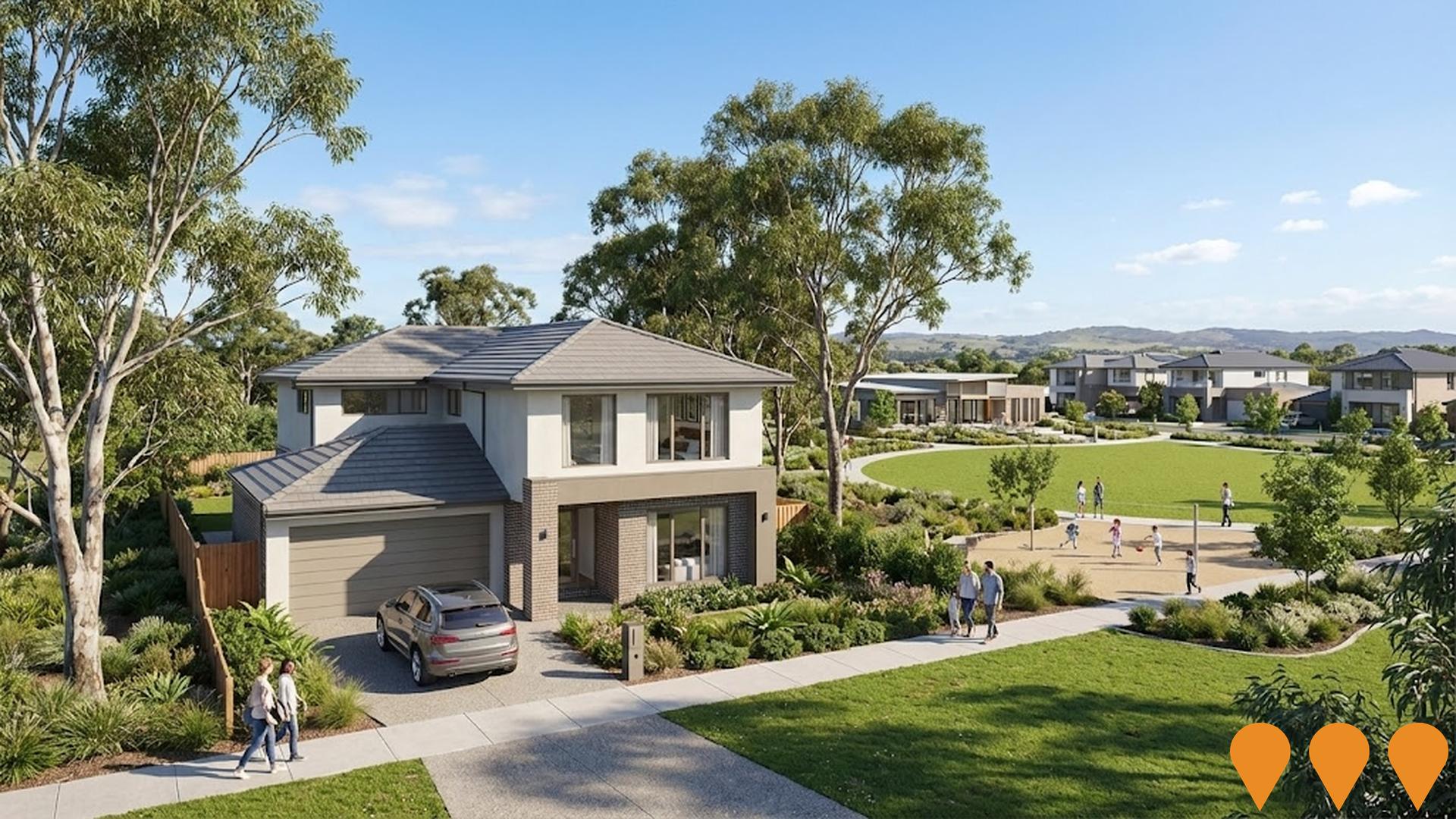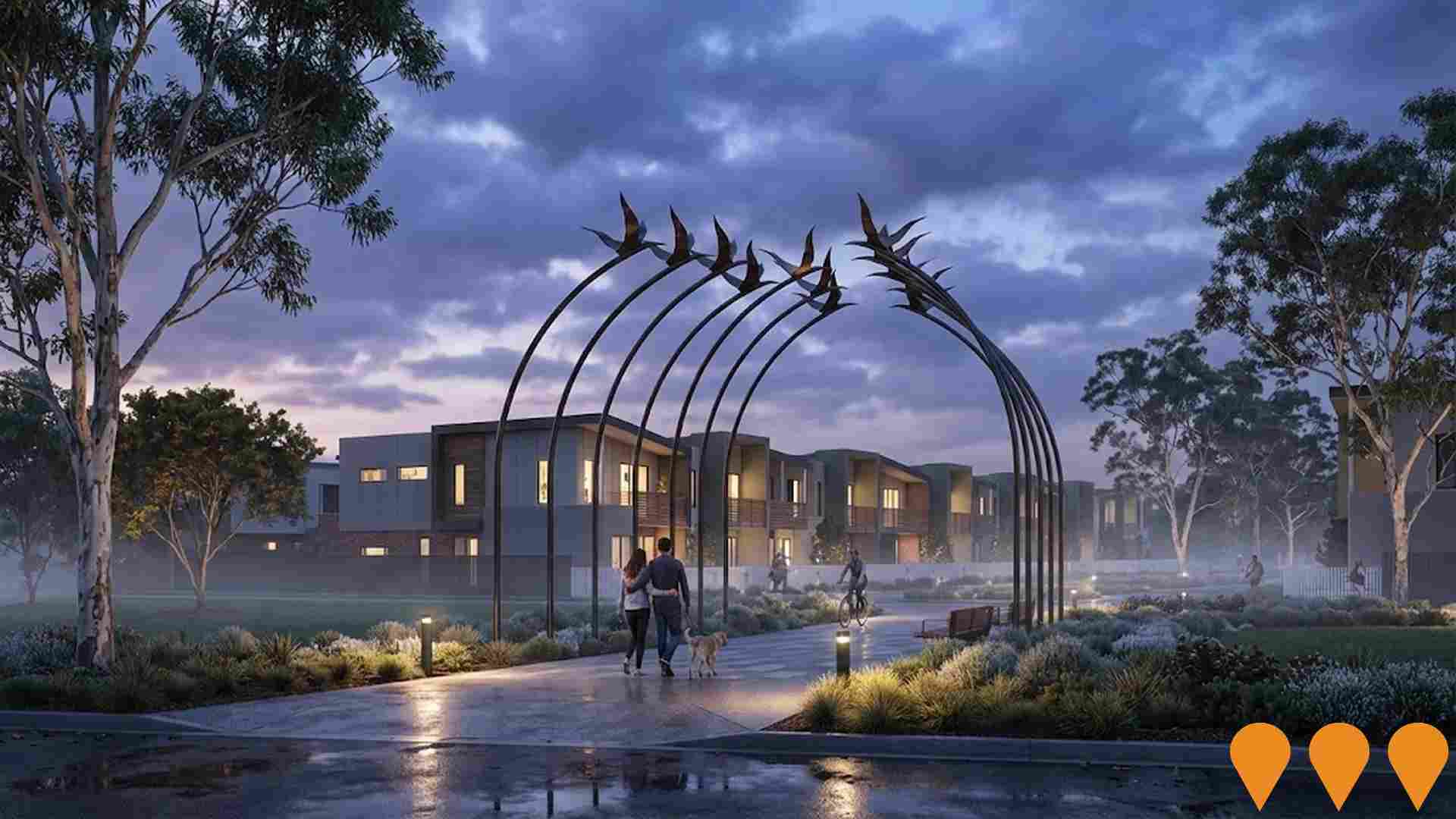Chart Color Schemes
est. as @ -- *
ABS ERP | -- people | --
2021 Census | -- people
Sales Activity
Curious about local property values? Filter the chart to assess the volume and appreciation (including resales) trends and regional comparisons, or scroll to the map below view this information at an individual property level.
Find a Recent Sale
Sales Detail
Population
Wollert lies within the top 10% of areas nationally in terms of population growth performance according to AreaSearch analysis of short and medium-term trends
Wollert's population is approximately 41,068 as of August 2025. This represents an increase of 16,661 people since the 2021 Census, which reported a population of 24,407. The growth from June 2024 to August 2025 is inferred from the estimated resident population of 33,614 and an additional 4,007 validated new addresses since the Census date. Wollert's population density as of August 2025 is 762 persons per square kilometer. The area's growth rate of 68.3% from the 2021 census exceeds both national (8.6%) and state averages, positioning it as a growth leader in the region. Interstate migration contributed approximately 68.4% of Wollert's population gains during recent periods.
AreaSearch projects Wollert's population to grow by 48,840 persons to 2041 based on ABS/Geoscience Australia projections released in 2024 with a base year of 2022. This projected growth reflects an increase of 100.7% over the 17-year period from 2025 to 2041.
Frequently Asked Questions - Population
Development
The level of residential development activity in Wollert was found to be higher than 90% of real estate markets across the country
Wollert has seen approximately 1,068 new homes approved annually. Over the past five financial years, from FY21 to FY25, around 5,340 homes were approved, with an additional 318 approvals in FY26 as of now. On average, each dwelling constructed over these years has accommodated about three new residents per year.
This demand significantly outpaces supply, typically exerting upward pressure on prices and intensifying competition among buyers. The average construction cost value for new dwellings is $369,000, which is lower than regional levels, indicating more affordable housing options for buyers. In FY26, Wollert has registered around $114.9 million in commercial approvals, suggesting robust commercial development momentum. Compared to Greater Melbourne, Wollert records 212.0% more new home approvals per capita, offering ample choice for buyers. This level of activity is notably above the national average, reflecting strong developer confidence in the area.
Regarding housing types, Wollert maintains its traditional low-density character, with approximately 84.0% standalone homes and 16.0% townhouses or apartments. With around 24 people per dwelling approval, Wollert exhibits characteristics of a growth area. Population forecasts indicate that Wollert is expected to gain about 41,350 residents by 2041. At current development rates, new housing supply should comfortably meet demand, providing favourable conditions for buyers and potentially supporting population growth beyond current projections.
Frequently Asked Questions - Development
Infrastructure
Wollert has strong levels of nearby infrastructure activity, ranking in the top 30% nationally
Changes in local infrastructure significantly affect an area's performance. AreaSearch has identified 42 projects that could impact this region. Notable ones include Wollert Neighbourhood Centre, Linfield Place Shopping Centre, Lyndarum North Estate, and Ellery Wollert. The following list details those likely to be most relevant.
Professional plan users can use the search below to filter and access additional projects.
INFRASTRUCTURE SEARCH
 Denotes AI-based impression for illustrative purposes only, not to be taken as definitive under any circumstances. Please follow links and conduct other investigations from the project's source for actual imagery. Developers and project owners wishing us to use original imagery please Contact Us and we will do so.
Denotes AI-based impression for illustrative purposes only, not to be taken as definitive under any circumstances. Please follow links and conduct other investigations from the project's source for actual imagery. Developers and project owners wishing us to use original imagery please Contact Us and we will do so.
Frequently Asked Questions - Infrastructure
Wollert Rail Extension
Proposed heavy rail extension from the existing Mernda Line to serve the growing Wollert and Epping North growth areas. The project remains in early planning with the Victorian Government undertaking corridor identification, feasibility studies and land reservation work through the Wollert Precinct Structure Plan. No funding has been committed for construction and no firm timeline exists beyond ongoing planning and advocacy.

Wollert Neighbourhood Centre
A $40 million mixed-use neighbourhood centre designed by OMA for the rapidly growing Wollert community in Melbourne's north. The 9,000sqm development integrates a full-line supermarket, specialty retail, childcare, community health services, pharmacy, education spaces, public courtyard, amphitheatre and an accessible rooftop for sports and urban agriculture. Construction commenced in early 2025 with practical completion expected late 2026.

Mason Quarter
Mason Quarter is a 64-hectare masterplanned community in Wollert, 25 km north of Melbourne CBD. The estate will deliver over 900 new homes (increased from original 800+), two future schools, an early learning centre and kindergarten (now under construction), sporting reserves, 7.9 ha conservation area and more than 30 tree reserves protecting river red gums. Civil works and home construction are well underway as of 2025.

Linfield Place Shopping Centre
A $45 million neighbourhood shopping centre developed by Oreana Property Group on Epping Road, Wollert. The centre provides approximately 3,500 sqm of retail and commercial space with confirmed tenants including 7-Eleven, Oporto, Snap Fitness, Aspire Early Education & Kindergarten, Bottle Mart and multiple specialty stores. Construction commenced in early 2025 with practical completion expected in Q1 2026.

Ellery Wollert
Ellery is a boutique residential community in Wollert featuring 300 lots across 25 hectares. The masterplan retains historic River Red Gum trees and includes pocket parks, future waterways, and wetlands. With Stages 9 and 10 now titled and ready for construction, Ellery offers premium lots with wetland views in one of Melbourne's fastest-growing northern suburbs.

West Wollert Community Centre
$16.2 million multi-purpose community centre for Wollert's rapidly growing community. The facility will include a three-room kindergarten creating 198 new places, two maternal and child health consulting rooms, community lounge/library space, community hall with commercial kitchen, bookable activity room, staff room and office, community garden and outdoor play area, accessible amenities including a Changing Places facility, and off-street parking.
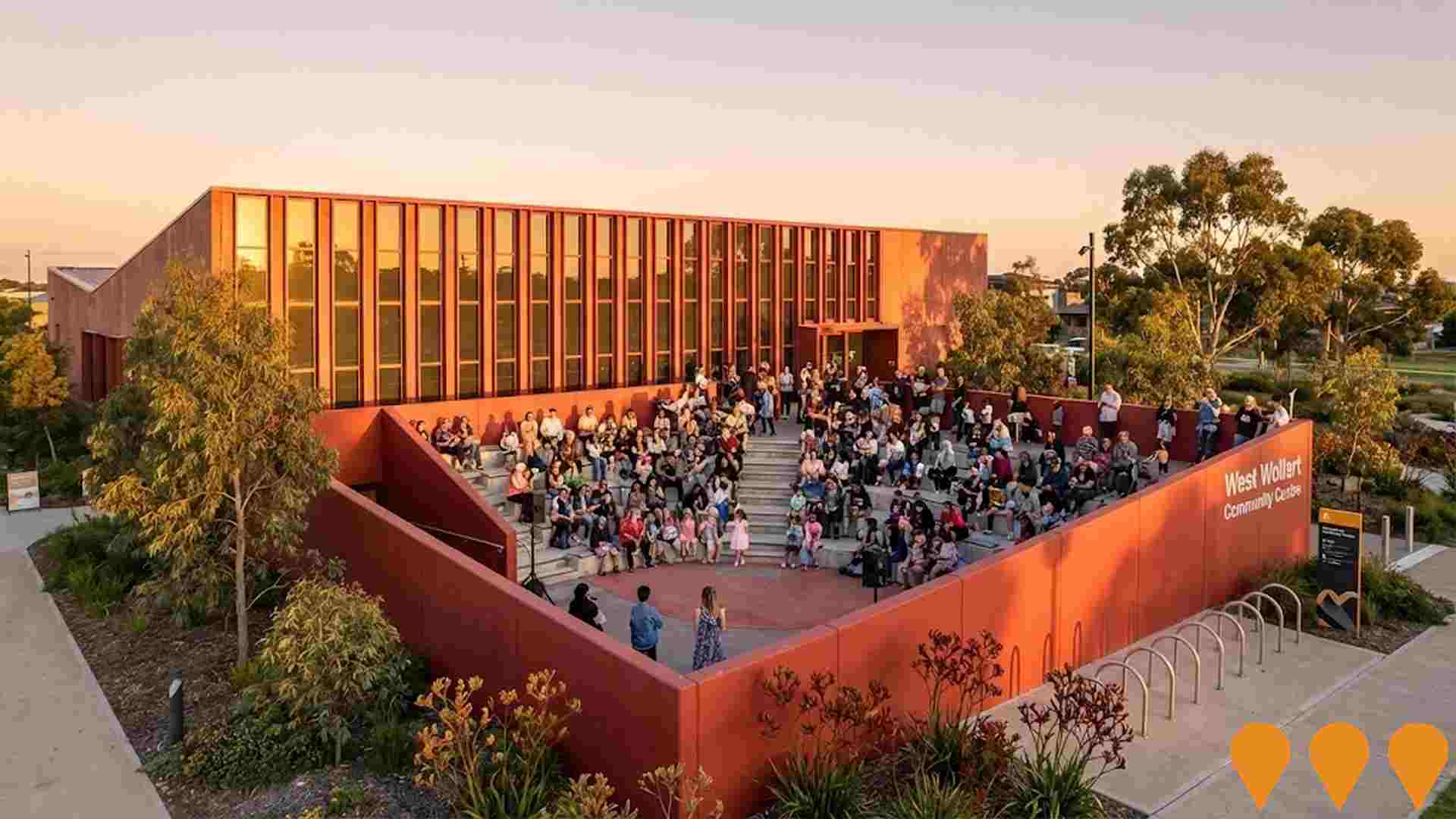
Linfield Place
Linfield Place is a premium architecturally designed shopping centre setting a new benchmark for convenience retailing in Melbourne's north. The $45 million development will deliver approximately 3,500 sqm of lettable space with 24 high-quality tenancies, including secured retailers 7-Eleven, Oporto, Aspire Early Learning & Kindergarten, Snap Fitness, and Bottle Mart. Located on the corner of Epping Road and Baltrum Drive, it is the only shopping centre on Epping Road in Wollert, perfectly positioned to service the rapidly growing northern growth corridor population.
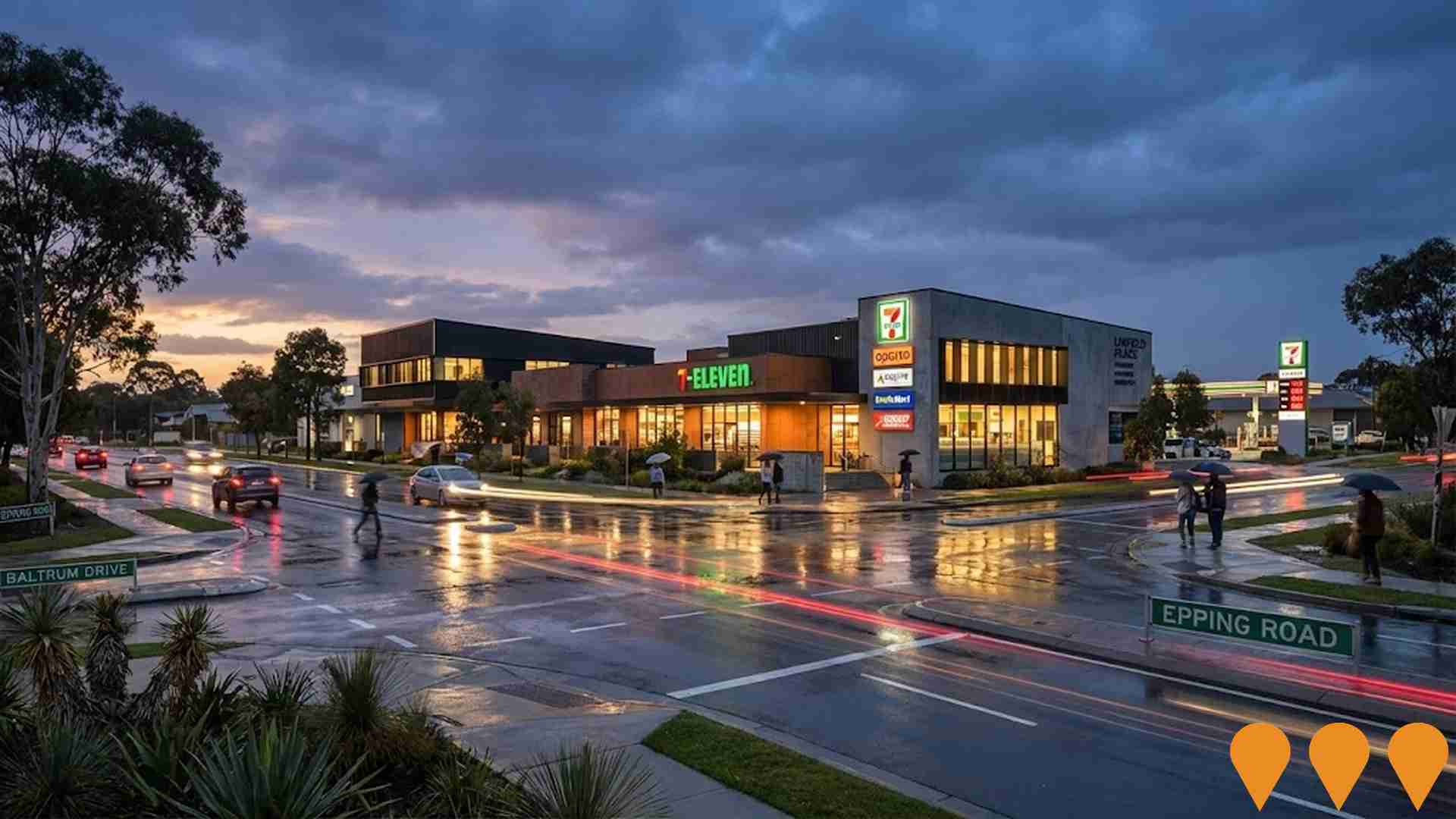
O'Herns Logistics Park
A large-scale industrial and logistics development spanning 259.3 hectares with 118.1 hectares developable, permit-ready for up to 700,000 sqm of warehousing. Stage 1 construction is currently underway with completion expected mid-2025. The project features sustainable design principles targeting 5-Star Green Star rating, including solar power, LED lighting, and rainwater harvesting. Features a 127-hectare conservation area at its center.
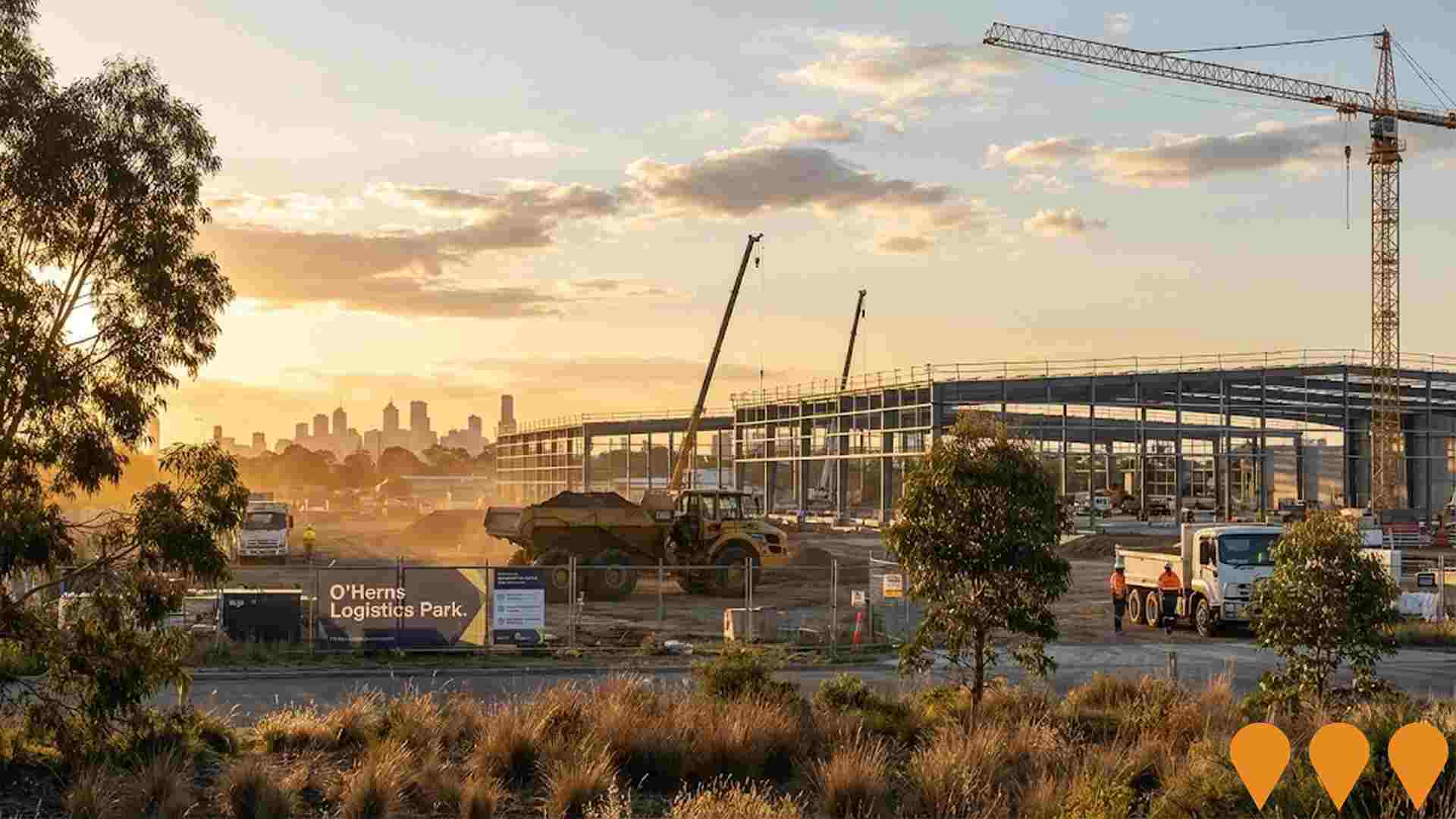
Employment
Employment performance in Wollert has been broadly consistent with national averages
Wollert has a highly educated workforce with notable representation from essential services sectors. Its unemployment rate is 3.7%, lower than the national average, and it experienced an employment growth of 1.5% over the past year.
As of June 2025, Wollert had 16,475 residents employed, with an unemployment rate of 0.9% below Greater Melbourne's rate of 4.6%. Workforce participation in Wollert was higher at 69.3%, compared to Greater Melbourne's 64.1%. The leading employment industries among residents were health care & social assistance, construction, and transport, postal & warehousing. Notably, Wollert showed strong specialization in transport, postal & warehousing, with an employment share of 2.0 times the regional level.
Conversely, professional & technical services had lower representation at 5.0% compared to the regional average of 10.1%. AreaSearch analysis of SALM and ABS data for the 12-month period ending June 2025 showed employment increasing by 1.5%, labour force increasing by 1.4%, and a fall in unemployment rate by 0.1 percentage points. In contrast, Greater Melbourne experienced employment growth of 3.5% and labour force growth of 4.0%, with an increase in unemployment rate by 0.5 percentage points. Jobs and Skills Australia's national employment forecasts from May 2025 project a 6.6% expansion over five years and 13.7% over ten years. Applying these projections to Wollert's employment mix suggests local growth of approximately 6.5%% over five years and 13.7% over ten years, assuming constant population projections for illustrative purposes.
Frequently Asked Questions - Employment
Income
Income levels align closely with national averages, indicating typical economic conditions for Australian communities according to AreaSearch analysis
Wollert's median income among taxpayers was $51,984 with an average of $58,752 according to AreaSearch's latest postcode level ATO data for the financial year 2022. This is below the national average and compares to Greater Melbourne's median of $54,892 and average of $73,761. Based on Wage Price Index growth of 12.16% since financial year 2022, current estimates would be approximately $58,305 (median) and $65,896 (average) as of September 2025. According to the 2021 Census figures, incomes in Wollert cluster around the 61st percentile nationally. Distribution data shows that 45.6% of locals fall into the $1,500 - 2,999 income category, mirroring regional levels where 32.8% occupy this bracket. High housing costs consume 19.8% of income, but strong earnings place disposable income at the 59th percentile nationally. Wollert's SEIFA income ranking places it in the 5th decile.
Frequently Asked Questions - Income
Housing
Wollert is characterized by a predominantly suburban housing profile, with ownership patterns similar to the broader region
Wollert's dwelling structure in its latest Census evaluation showed 88.0% houses and 12.0% other dwellings. This compares to Melbourne metro's 87.2% houses and 12.8% other dwellings. Home ownership in Wollert was at 11.4%, with mortgaged dwellings at 64.5% and rented ones at 24.1%. The median monthly mortgage repayment was $2,000, exceeding Melbourne metro's average of $1,900. Median weekly rent in Wollert was $391, compared to Melbourne metro's $371. Nationally, Wollert's mortgage repayments were higher than the Australian average of $1,863, and rents exceeded the national figure of $375.
Frequently Asked Questions - Housing
Household Composition
Wollert features high concentrations of family households, with a higher-than-average median household size
Family households constitute 85.6% of all households, including 55.6% couples with children, 18.8% couples without children, and 10.0% single parent families. Non-family households account for the remaining 14.4%, with lone person households at 12.1% and group households comprising 2.3%. The median household size is 3.3 people, which is larger than the Greater Melbourne average of 2.9.
Frequently Asked Questions - Households
Local Schools & Education
The educational profile of Wollert exceeds national averages, with above-average qualification levels and academic performance metrics
The area's university qualification rate is 35.3% for residents aged 15+, exceeding the SA3 area average of 25.9% and Australia's average of 30.4%. Bachelor degrees are most common at 21.6%, followed by postgraduate qualifications (11.4%) and graduate diplomas (2.3%). Vocational credentials are held by 30.7% of residents aged 15+, with advanced diplomas at 14.5% and certificates at 16.2%.
Educational participation is high, with 35.6% currently enrolled in formal education: 13.9% in primary, 7.0% in secondary, and 4.8% in tertiary education. Wollert has a robust network of six schools educating approximately 3,624 students, with typical Australian school conditions (ICSEA: 1028) and balanced educational opportunities. There are four primary and two secondary schools serving distinct age groups. School places per 100 residents is 8.8, below the regional average of 13.1, suggesting some students may attend schools in adjacent areas.
Frequently Asked Questions - Education
Schools Detail
Nearby Services & Amenities
Transport
Transport servicing is moderate compared to other areas nationally based on assessment of service frequency, route connectivity and accessibility
Transport analysis shows 36 active stops in Wollert, served by a mix of buses. These stops are covered by four routes, offering 4,837 weekly passenger trips. Transport access is moderate, with residents located around 446 meters from the nearest stop on average.
Services run approximately 691 trips daily across all routes, translating to about 134 weekly trips per stop.
Frequently Asked Questions - Transport
Transport Stops Detail
Health
Wollert's residents boast exceedingly positive health performance metrics with prevalence of common health conditions quite low across both younger and older age cohorts
Wollert shows excellent health outcomes with low prevalence of common conditions across both younger and older age groups. Private health cover stands at approximately 49% (around 20,164 people), lower than the national average of 55.3%.
Asthma and mental health issues are the most prevalent conditions, affecting 5.2 and 4.2% respectively. About 84.6% of residents report no medical ailments, compared to 74.0% in Greater Melbourne. Wollert has 6.4% (2,628 people) aged 65 and over, lower than Greater Melbourne's 13.2%. Despite this, seniors' health outcomes require more attention than the broader population.
Frequently Asked Questions - Health
Cultural Diversity
Wollert is among the most culturally diverse areas in the country based on AreaSearch assessment of a range of language and cultural background related metrics
Wollert has one of the most culturally diverse populations in Australia, with 51.8% born overseas and 67.4% speaking a language other than English at home. Christianity is the predominant religion in Wollert, practiced by 36.4% of its population. The category 'Other', however, comprises 13.6%, significantly higher than Greater Melbourne's average of 4.4%.
Regarding ancestry, the top three groups are Other (33.4%), Indian (16.5%), and Australian (10.2%). Wollert has notably higher percentages for Other and Indian compared to regional averages, but a lower percentage for Australian. Other ethnic groups with notable differences include Macedonian at 4.4% in Wollert versus 4.6% regionally, Sri Lankan at 1.2% versus 0.8%, and Lebanese at 2.2% versus 1.7%.
Frequently Asked Questions - Diversity
Age
Wollert hosts a very young demographic, ranking in the bottom 10% of areas nationwide
Wollert has a median age of 31, which is lower than the Greater Melbourne average of 37 and the Australian median of 38. Compared to Greater Melbourne, Wollert has a higher percentage of residents aged 35-44 (22.4%) but fewer residents aged 55-64 (5.6%). This 35-44 age group is significantly higher than the national average of 14.2%. Between 2021 and present, Wollert's population has seen an increase in the 45 to 54 age group from 8.3% to 10.4%, and a rise in the 5 to 14 cohort from 17.4% to 18.6%. Conversely, the 25 to 34 age group has decreased from 21.3% to 16.3%, and the 0 to 4 age group has dropped from 11.7% to 9.3%. By 2041, demographic projections suggest Wollert's age profile will change significantly, with the 45 to 54 age cohort expected to expand substantially by 8,617 people (201%), growing from 4,291 to 12,909.

